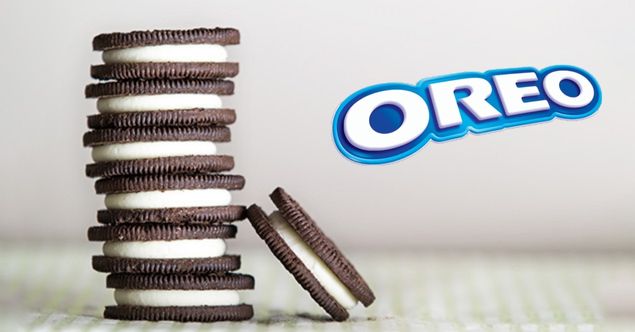Originating in the US, Oreo became an icon of trend-setting biscuits. Breakfast tables worldwide were filled with this dark, round treat that was so easy to recognize - particularly amongst Indian consumers.
Yet, how did a single cookie become so popular in India?
The answer is two-parts: innovation and advertising. Oreo took flavor profiles to new heights with unique (and delicious!) flavours.
Oreo is an American cookie brand, which is owned by Mondelez International & Cadbury Milka. Back on March 6, 1912, is celebrated as National Oreo Day because, at the National Biscuit Company factory in New York City, the Oreo Cookie was invented.
And in 2011, this biscuit was brought to the Indian Market by Cadbury India to Indian Market. Now it is having 7% of the market share in the biscuit segment, though it is quite costly as compared to other biscuit sectors and is considered a luxurious biscuit in India.
Oreo is a sandwich cookie consisting of two wafers with a sweet yummy crème filling of various flavours like chocolate, milk, red velvet, and many more.
The company sells its products in over one hundred countries across the globe with different packaging and limited edition offers.
On March 6, 2012, the popular cookie brand, Oreo, celebrated its 100th birthday. From a humble start in a Nabisco bakery in New York City, Oreo has grown to become the best-selling cookie brand of the 21st century generating $1.5 billion across the world annual revenues. Today it is owned by Kraft Foods Inc, Oreo is one of the company's dozen billion-dollar brands.
Until the mid-1990s, Oreo aimed at the US market - as reflected in one of its famous advertising slogans from the 1980s, "America's Best Loved Cookie". But the dominant position in the US limited growth opportunities in the market and spurred Kraft to turn to international markets.
Moreover, the brand’s marketing campaigns struck a chord with consumers through colourful and unbelievable visuals focused on indulgence and playfulness. What’s more, their collaborations with popular films added an extra flair of desirability as well as created awareness about the diverse range of flavours available for consumption.
Finally, these pillars all relied on what is at the core of Oreo’s success – meaningful conversations supported by research & a deeper understanding of Indian consumers & culture-specific insights from local marketing tactics across digital media platforms like Twitter & Facebook.
Such innovative product design along with enticing ads made for a winning combination that resonated well enough to allow Oreo to quickly become not only one of the most recognizable biscuit brands in India but also one of the most popular.
Oreo was launched in China
Oreo was launched in China in 1996. The China launch was based on the implicit assumption that what made it hugely successful in its home market would be a winning formula in any other international market.
According to Lorna Davis who is president of multinational consumer goods companies, and in charge of the global biscuit division at Kraft. The team considered pulling Oreo out of the Chinese market altogether.
In 2005, Kraft decided to research the Chinese market to understand why the Oreo cookie that was so successful in most countries had failed to make a mark in china. Research showed the Chinese were not historically big cookie or biscuits eaters,
According to Lorna, Chinese consumers liked the contrast of sweet and bitter taste but "they said it was a little bit too sweet and a little bit too bitter" for them.
The other problem was that the shape could be quite alien without the emotional attachment of American consumers who grew up with the cookie. In addition, 72 cents for a pack of 14 Oreos was too expensive for value-conscious Chinese consumers.
Kraft's Chinese division used this information to formulate a modified recipe, making the cookie more chocolatey and the thick cream less sugary.
Kraft developed 20 prototypes of reduced-sugar Oreo cookies and tested them with Chinese consumers before arriving at the perfect formula that tastes right. They also came with different kinds of packages and included smaller packets for just 29 cents to cater to Chinese buying habits.
The changes boosted sales and an ambition to capture a more significant share of the Chinese biscuit market led Kraft to reproduce the product in 2006 and introduce an Oreo that looked almost nothing like the original.
The new Chinese Oreo consisted of four layers of crispy wafers filled with thick vanilla and chocolate cream, coated in chocolate. The local innovations continued and Oreo products in China today have different flavours including Oreo green tea ice cream and Oreo Double-Fruit.
Another problem with Chinese consumers was introducing the typical twist, lick and dunk ritual used by American consumers to enjoy their Oreos cookies. Americans traditionally love to twist open their Oreo cookies, lick the cream inside and then dunk it in milk.
Such behaviour was considered a "strangely American habit" which was accepted by the Chinese, according to Davis. But the marketing team noticed China's growing thirst for milk which Kraft tapped with a grassroots marketing campaign to tell Chinese consumers about eating cookies like the American tradition of pairing milk with cookies.
A product tailored for the Chinese market and a campaign to market the American style of pairing Oreos with milk paid off and Oreos became the bestselling cookies of China.
Oreo's Launch in India
The lessons from the Chinese market have shaped the way Kraft has approached Oreo's launch in the Indian market. Oreo came to India through the import route and was priced at Rs 50 (about $1) for a pack of 14.
But sales were insignificant partly because of limited availability in the Indian market and awareness, but also because they were prohibitively expensive for the value-conscious Indian consumers.
Learning from the Chinese success story, the company under global CEO Irene Rosenfeld took localisation market strategies very seriously from 2007 onwards. The $19.1-billion acquisition of Cadbury in the year 2009 provided Kraft with the local foothold it needed for the Indian market.
And in the year 2011, this biscuit was relaunched again to the Indian Market by Cadbury India. Now it is having 7% of the market share in the biscuit segment, though it is a bit costly as compared to other biscuits and is considered a luxurious biscuit brand in India.
Unlike the Chinese, Indians love their biscuits more than cookies. Nielsen says India is the world's biggest market for biscuit consumers with a market share of 22 % in volumes compared with 12% in the US.
While the lion's share of this market is for low-cost glucose biscuits which are led by Parle-G, premium creams account for a substantial chunk valued at around Rs 5,500 crore ($1.1 billion). The way to the Indian consumer's stomach is through competitive costing, high volumes and strong distribution, especially in rural areas.
Oreo developed a marketing strategy around taking on existing market leaders in the cream segment in India - Britannia, Parle and ITC.
The focus was to target the top 10 million households which account for 75% of cream biscuit consumption. It entered the market as Cadbury Oreos because Cadbury is a stronger brand name than Kraft, in the Indian market and initially focused on generating awareness and rapid trials.
The product was sweetened cream to suit the Indian palate and Kraft exploited Cadbury's network of 1.3 million stores.
The Made in India tag on packaging meant using locally-sourced ingredients, modification of the recipe to suit Indian consumers' tastes and possibly cheaper ingredients, smaller size and competitive prices according to market.
Oreo launched its traditional chocolate cookie with vanilla cream at just Rs 5 for a pack of three to drive impulse purchases and trials, Rs 10 for a pack of seven and Rs 20 for a pack of 14 for heavy usage. The cookie looks the same as its international package with a motif of 12 florets and 12 dashes.
Kraft initially chose to outsource its manufacturing for the Indian market instead of using Cadbury factories in India.
For marketing purposes, the company focused on using the togetherness concept to sell Oreos in the country, with television forming the main medium of communication although other media are also being focused on.
Oreo India's Facebook page was one of the fastest-growing in the world. The company also went on a bus tour and billboard to push the concept of togetherness among families across nine cities and it used a smaller vehicle for a similar campaign across 450 small towns in India.
Oreo is driving point-of-purchase and selling with store displays and in-store promotions in a bid to overtake Indian market leader Britannia Good Day's distribution.
With a marketing strategy focused on rapid brand awareness and extensive distribution, the Oreo India launch story has been a success today. Its market share has grown from a little over 2% after its debut to a huge 30% of the cream biscuit market.
Today Kraft has shifted from the Cadbury distribution network to a wider wholesale channel in India. It is also eyeing kirana stores and small towns apart from modern stores in big cities across the country. Today, Oreo is more than just an American cookie brand.
Marketing Strategies of Oreo
1. Oreo Customizes its Cookies
Its customized design attracts new customers, especially kids and parents who follow everything that’s in trend in the market to buy the products which makes it stand out from its competitors and builds a unique image.
For example :
1. Back in the year 2019 when the finale season of Game of Thrones came, Oreo made a limited edition cookie inspired by the show, letting fans explore the new product and relate to a theme. This allowed the brand to find a common interest with its target audience.
2. To celebrate Halloween in the year 2020, they had a black cookie with a ghost saying ‘boo’ with orange filling.
2. Market Penetration Strategy
When the oreo cookie was launched in the market, the cost was low to grab the target market but eventually when it became familiar and popular in the Indian market, the price was increased and now it is considered one of the best-branded biscuits around the world.
Initially, as it was available at a nominal cost, people didn’t mind trying something new and in time got adapted to it. This marketing strategy worked very well for the company and gave it exceptional results.
3. Content Marketing
Oreo uses content marketing to grab attention in consumers’ minds. It ensures that the content is relatable and exclusive for individual consumers to engage and relate to it.
Oreo came with its first-ever Rainbow cookie in honour of its partnership with PFLAG National, which is a massive organization supporting LGBTQ+ people and their parents. Colourful cookies grab the attention of the consumer easily as it's something unique and as someone buys them, they also generate awareness in society.
The Oreo social media and TV ads always leave cute messages for their target customers to engage them. Oreo also uses celebrity endorsements as one of its best marketing strategies to build its brand name and for brand recognition.
Strengths of Oreo
- Large Distribution: Cadbury has a huge distribution in India. It has retailers and a chain of distribution from rural to urban areas in the country.
- Global Market: Oreo is owned by Cadbury and Mondelez International company. It has a massive market that is spread worldwide. One of the plus points of Oreo is it connects to the target audience through digital marketing channels.
- Good Quality Packaging: As was stated when Oreo has a good marketing team that helps the brand to become big in the Indian market. According to the market, they adopt the new edition and packaging that helps the brand to make it international at the same time.
- Brand Trust: Cadbury Oreo has been in the Indian market for more than 10 years so it was easy for Oreo to make it a marketplace in the Indian Market. Over the years it has gained the trust of Indian customers which makes the Cadbury Oreo gain high brand equity.
Weaknesses of Oreo
- Limited Target Group: Oreo has a very limited target audience that prefers cream biscuits.
- Competition is High: With the changing Indian market environment, many new products are coming into the cookies industry.
- Expensive Advertisement: Cadbury’s Oreo spends a massive amount of money on advertising. As advertising is an essential part of sales they have to make sure that advertising is done properly.
- Criticisms: As the biggest brand in the industry it has to go through different criticisms in the country. Bad publicity can affect the image of the brand. For example, some people consider cookies bad for health.
What Oreo stands for?
The most common version asserts that Oreo derives from or, French for "gold" and supposedly the colour of the original packaging. Others say it stands for "orexigenic," a medical term for substances that stimulate the appetite (including cannabis)
Amazing facts about Oreo
Oreo is managed by Mondelez International, which is a spin-off of Kraft Foods (acquirer of Nabisco).
It takes 2 hours (process time) to bake 1 Oreo cookie.
The total amount of Oreo cookies made in a year would circle the Earth 5 times.
40 bn Oreo Cookies/biscuits are produced each year.
Oreo Way- Name of a street in New York City where the first Oreo was made.
Summary
Oreo is a renowned cookie brand worldwide, having its operation worldwide. It operates in almost every country and has a sweet cookie relationship with its customers. They always try to grab the customer’s attention through different sorts of ads and sometimes merge the same with some trending topic in society.
They have always stayed in the spotlight and used ingenious strategies to become market leaders. Did you know? OREO.com has everything you want from your favourite brand - recipes, OREO cookies, Personalized gifts, merchandise, and brand purposes.
FAQ's on Oreo:
Mondelez India Foods Pvt. Ltd., headquartered in Mumbai, Maharashtra is a powerhouse of iconic brands & local jewels of brands such as Cadbury, Tang, Bournvita, Oreo, 5 Star and much more.
First introduced in the U.S. in 1912, Oreo has become the world's top-selling cookie and is enjoyed in over 100 countries.
Oreo cookies do not contain animal-derived ingredients and are safe to eat for vegans.





